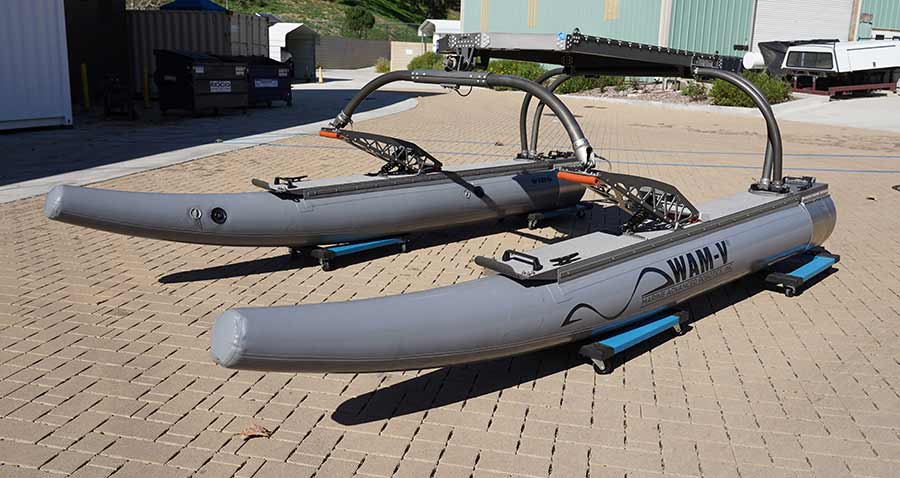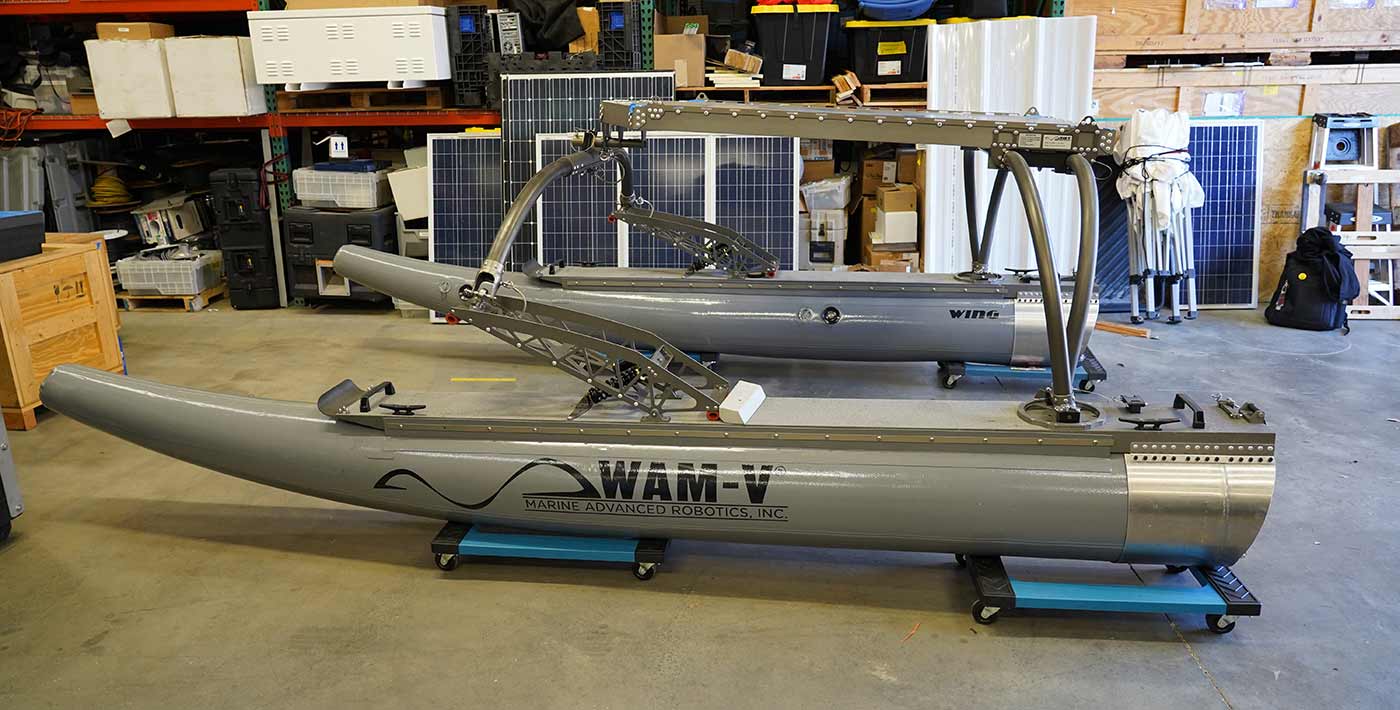
By:
- Katherine Connor
Published Date
By:
- Katherine Connor
Share This:
Engineering Students to Compete in International Maritime Robot Competition

All teams participating in the Maritime RobotX Challenge start with the same wave adaptive modular vessel (WAM-V); their challenge is to add a suite of sensors and software that will allow it to function autonomously. Photos and video by Daniel Sosa-Cobo.
For the past three months, a team of engineering students at UC San Diego has been adding cameras, LiDAR systems, a hydrophone, and even a drone to a 16-foot seagoing vessel. Their goal? To compete in the Maritime RobotX Challenge in Australia in November 2022. In order to get there, they’ll have to turn the vessel into a completely autonomous system, capable of navigating to specific buoys, launching objects at a target, and working with a drone to map out the sea space, entirely on its own.
They are under no illusions: it’s a difficult task. But it’s a welcomed challenge that, for several of the students, has been more than 10 years in the making, thanks to the FIRST (For Inspiration and Recognition of Science and Technology) robotics outreach program, and RoboNation, the nonprofit organization behind RobotX.
“Way back in third grade, our FIRST Robotics coach wanted us to work toward underwater robotics; we started with land vehicles for the first eight years, then transitioned to underwater vehicles, initially with an 18-inch cubed underwater submersible for the RoboSub competition. The next progression of RoboSub is RobotX, which is the university-level competition, and we’re finally getting to participate this year,” said Colin Szeto, a first-year mechanical engineering student at the Jacobs School of Engineering.
When Szeto and several other RoboNation participants arrived at UC San Diego last fall, they knew they wanted to compete in the RobotX challenge. Working with Jack Silberman, a longtime FIRST Robotics coach for Team Inspiration and a lecturer for the UC San Diego Contextual Robotics Institute, as well as fellow engineering students and several former Team Inspiration teammates still in high school, the students developed and submitted their project proposal. When they found out their proposal had been accepted, they got to work, turning the wave adaptive modular vehicle (WAM-V) that all participating teams are sent as a standard starting platform, into an autonomous maritime system.
“This is an autonomous competition, so we need different sensors to maneuver around the water and determine where we are on the field,” said Daniel Scuba, also a mechanical engineering freshman, who participated in FIRST Robotics in high school and is on the team. “Some of the sensors we’ll be adding to the WAM-V include a LiDAR sensor to locate buoys in the water; as well as a hyperspectral imaging camera on the drone, and more cameras to help with way-finding. We also use a hydrophonic sensor to determine the underwater pinging frequency from a modem.”
Typically, about 15 teams from around the world compete in this weeklong biennial competition; so far, the UC San Diego team is the only competitor from California, and one of only a handful from the United States. Points are scored by completing one of several tasks, including: navigating to a certain colored buoy; maneuvering around a series of gates; launching an object at a target; working in collaboration with a drone to identify another colored marker and navigating to it; avoiding staged, fake wildlife encounters; and docking at a specific bay.
Once the competition is complete, the team plans to transition the WAM-V to scientists at UC San Diego for use in maritime field work. With this in mind, the students are configuring the mechanical systems to accommodate extra payloads, and configuring the electronic system with open ports to interface with any sensors that researchers may want to add.

The platform on top of the WAM-V will serve as home base for the autonomous drone the students are developing.
For Szeto, this is one of the neatest parts of the challenge: being exposed to the maritime domain, and learning how robotics and autonomy can intersect with earth sciences.
“I think it’s cool to be exposed to a different field of robotics,” said Szeto. “The maritime domain is not something I grew up with, but it’s super exciting to see different scientists and students be so passionate about saving the ocean, and being able to help humanity by taking care of our environment. And the system here is a vehicle for us to learn more about the oceans as well as learn more about different technology for the future.”
For Scuba, he’s most enjoying learning about the roles of the different sensors they’re using, and how to integrate them all together.
“I’m not as knowledgeable about the sensors since I come from more of a mechanical background in robotics, so I’m not used to integrating all these different types of sensors from an industrial standard; I’m more used to smaller sensors that integrate more easily. So, it’s interesting to learn how to adapt to an industry standard, and these industry level materials like motors and propulsion systems, to integrate them all together.”
With the competition still 10 months away, the team has a lot of work ahead of them.
“My FIRST Robotics Team Inspiration co-coach Alex Szeto, a systems engineer at Northrop Grumman, and I are excited that these students have this unique opportunity to learn new technical skills as they work toward the international competition,” said Silberman. “The team is open to any UC San Diego students who want to participate and expand their skills while advancing our STEM outreach efforts.”
To learn more about the team and get involved in this project or their ongoing STEM outreach efforts, visit the FIRST website.
Share This:
You May Also Like
Stay in the Know
Keep up with all the latest from UC San Diego. Subscribe to the newsletter today.


